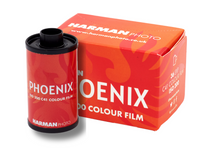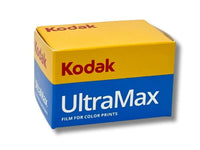Recent posts
Shop the article

Harman Phoenix 35mm Film Review: Our Customers' Perspective
By Paul McKay
In the ever-evolving world of film photography, the Harman Phoenix 35mm film has emerged as a compelling option for enthusiasts. Known for its unique characteristics and performance, this film sparked significant interest and discussion among our community when it launched in December. The next restock is here so in this detailed review we explore Harman Phoenix 35mm film through the lens of actual customer experiences.
Please note that we use customer's first names in the article - you can see the full reviews and more sample photos on the Harman Phoenix product page!
Cover Image (c) @busterchaytor
What Makes Harman Phoenix Stand Out?
Harman Phoenix 35mm film distinguishes itself in the market with its unique characteristics versus other films like Kodak UltraMax or Lomography CN400. According to Stevie, a customer who eagerly anticipated this film, its exceptional tonal range and vivid image production set it apart. "The colour rendition and clarity are simply astounding," they share.

(c) Ben Gorman
When compared to other films, Harman Phoenix shines with its versatility. It is praised for its adaptability in various shooting scenarios, from serene landscapes to dynamic urban settings. Ehsan, another customer, notes its suitability for both beginners and seasoned photographers, especially in street and landscape photography. Although they also comment "ISO 200 is too optimistic. I shot my first roll at 160 and it's obvious it can do with more light. I'm going to rate the next roll at 100 and see what I get"
This film is celebrated for striking a balance between quality and creative expression. Adam, a supporter of Harman Phoenix's development, remarks on its potential as a new alternative in the film market. The distinctive colour reproduction, especially the greens and reds, is a highlight for many users.
User Experiences with Harman Phoenix 35mm Film
The Harman Phoenix 35mm film has garnered a diverse range of feedback from its users. John found it performed exceptionally well in less-than-ideal light conditions, appreciating its distinctive colour palette. "I believe it is unfair to dismiss it as experimental," he comments.
Many photographers have noted the reliability and consistency of this film. Deborah, a customer who experimented with various settings, remarks, "when it works, it's glorious it's 5 stars." She appreciates the film's colours and grain and plans to continue using it, despite some minor colour anomalies.

(c) @debbsdale
Chris, sharing his trial experience with the film, highlights its adaptability. He notes that the film copes well with a variety of lighting conditions, which is crucial for photographers who explore different environments.
We also love some of the photos that The Darkroom in the US have captured in their review article.
Technical Aspects of Harman Phoenix 35mm Film
The technical specifications of Harman Phoenix 35mm film are key to its performance. Mark, who used the film for creative work, mentions shooting it at 100 ISO, which seemed to enhance the film's character. He observed that the high contrast and halation were significant aspects of his results, offering unique creative opportunities.

(c) Blott
Regarding grain and colour balance, the film offers a fine grain structure that adds texture to images without being overwhelming. Peter, who experimented with both C41 and E6 processes, was impressed with the results. His experience highlights the film's versatility and responsiveness to different development processes. Although if you're just starting out with Harman Phoenix we would always recommend C-41 development!

(c) pentaxpete
Overall, the technical characteristics of Harman Phoenix make it a suitable choice for various photographic styles. The film's balanced ISO and remarkable colour make it a versatile option for photographers looking to capture nuanced details and vibrant colours.
Halation with Harman Phoenix
Halation is a notable characteristic of Harman Phoenix 35mm film, as observed by several users. Mark Scott specifically set out to find scenes that maximised halation and high contrast. He found that the film's response to light, especially reflected light, added a unique 'tobacco' tone to his images, leading to a softness and loss of sharp edges in areas of intense light.

(c) Blott
Halation, the glowing effect around bright light sources in an image, adds an artistic touch to photographs. Deborah's experiences with Harman Phoenix in landscapes and low-light indoor settings revealed pleasant surprises. The film's tendency to produce intense colours and distinct grain patterns was evident in her results.
Understanding and harnessing this characteristic can open up creative avenues. Photographers can experiment with lighting conditions and composition to use halation to their advantage, creating images with an abstract or artistic flair.
The Verdict - Is Harman Phoenix 35mm Film Worth It?
After considering various customer experiences and reviews, the Harman Phoenix 35mm film stands out as a unique and versatile choice. It offers a blend of quality, creativity, and reliability that appeals to a wide range of photographers. As George, a photography teacher and frequent customer, puts it, "For both amateurs and professionals, Harman Phoenix offers something special."
While it may not be a traditional film, its distinct characteristics and potential for creative expression make it a valuable addition to any photographer's toolkit. The film's ability to handle different lighting conditions and produce vivid colours with a distinctive analogue look is a significant draw for many users.

(c) chrismojo
In conclusion, Harman Phoenix 35mm film is a worthwhile investment for those looking to explore the boundaries of film photography. Its unique properties offer a fresh perspective, making it a must-try for film enthusiasts looking to expand their creative arsenal.
And important point, as people have been asking whether Harman Phoenix is still being made on a large scale by Harman. The good news: YES it is being produced on an irregular schedule but it is an ongoing part of the output from Harman's film factory. So don't worry, it is worth taking the time to learn how to get the best from the film.
Personally I really enjoyed my results form a roll I shot in bright sunlight - so these example shots have shown me an entirely different side to Phoenix that I'm keen to explore!
Have you explored the creative possibilities of Harman Phoenix 35mm film? Share your experiences and join the conversation about this intriguing film option. What have been your favourite moments captured with Harman Phoenix?
Ready to dive in?
Keep Reading
View all
Experimenting with the Newest Addition: Ferrania P33 Film Review

Half-Frame vs. 110 Film: Compact Convenience

Analogue Appeal: Why Do People (Still) Shoot Film?
Subscribe to our newsletter 💌
Sign up for our newsletter to stay up to date on film photography news, sales and events:
Free Tracked Shipping
On all UK orders over £50
Passion For Film
An unbeatable range and an on-site lab
Our Customers Trust Us
Thousands of independent 5* reviews
All Deliveries are Carbon Neutral
Independently audited and verified by Planet
- Opens in a new window.







1 Comment -
Dale •
Can we hope to see Phoenix released in 120 format?